“Life is short, and this is one of the better ways to spend a lot of it.”
– A customer enjoying a bowl of chili on the Food Network’s Diners, Drive-ins and Dives.
He may have been talking about chili, but that fellow could have just as easily been talking about SPAH (Society for the Preservation and Advancement of the Harmonica): an organization that, like the instrument it honors, brings people together.
More than a group of harmonica enthusiasts, says President Michael D’Eath. “It is a collaboration, where everybody shares with everybody. It’s not about being better than somebody, it’s about helping someone.”
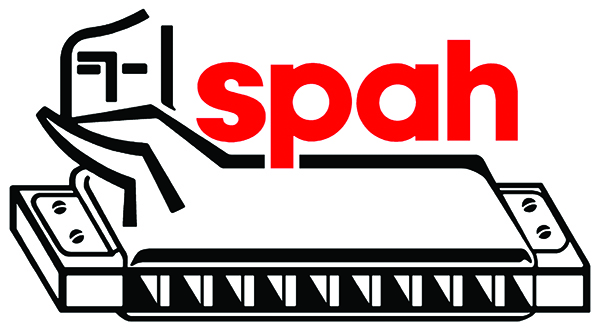
And he’s not just whistling Dixie or, more likely, God Save the Queen, as Michael was born and raised in England.
I have seen firsthand the difference SPAH can make in someone’s life: the joy it brings, the mountains it moves, the music it makes and the friendships it fosters, friendships that last a lifetime.
A week or so ago, I joined Michael and past president Paul Davies on a three-way conference call that was a happy mix of great memories and expectations.
Today, SPAH boasts close to a thousand members. But back in the fall of 1962, it was nothing more than an idea, one man’s desire to hook up with other harmonica enthusiasts, share some tips, and play some music.
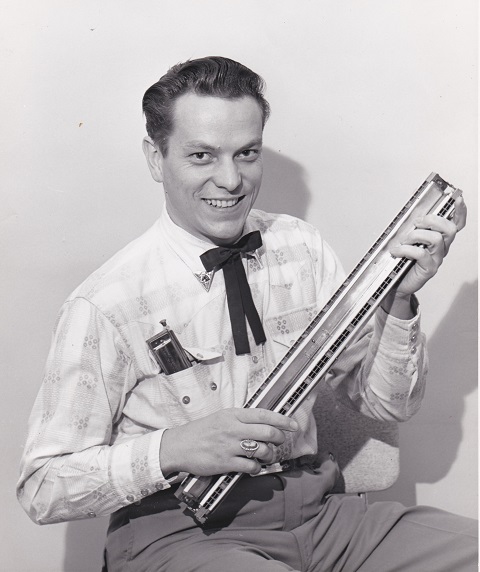
And so it was that Earl Collins Junior placed an ad or two in the local newspapers asking if there were any folks out there who might want to get together every now and again and play a tune or two. There was no major plan, no long-term goal, and no idea that these ads would attract more than a handful of like-minded folks.
But they did.
By the time the Christmas holidays rolled around, some 150 people had answered Earl’s ads, all of them anxious to get together for a little music making.

Earl worked for the Ford Motor Company in Dearborn, Michigan and, as it turned out, the company’s founder (Henry Ford) had been a harmonica player. Bet you didn’t know that. But Ford Motors did, and stepped up to the plate — or mic — providing the venue for the group’s first official meeting.
It took place on December 27, 1962 and, by October of the following year, the organization, now officially known as SPAH, Inc., had incorporated, with Earl and co-founders Gordon Mitchell and Richard Harris leading the charge.
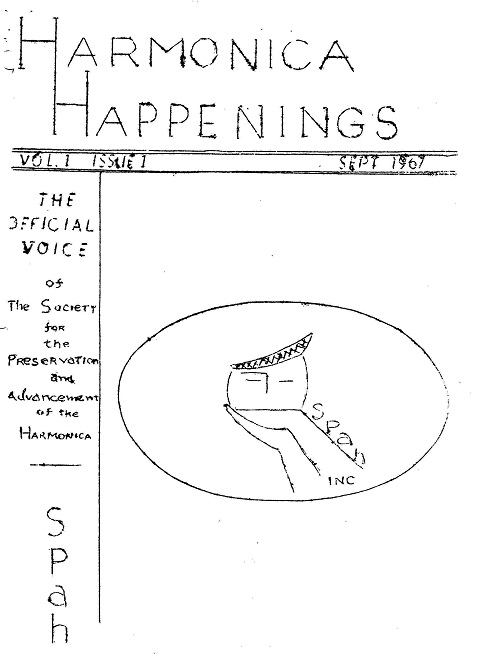
In 1967, the group published its first issue of Harmonica Happenings. It was, says Davies, a modest newsletter, “very homespun”, but it kept members in touch with the SPAH community, noting milestones —weddings, births and passings — along with an article about a professional player. And that was about it.
But, as time went on, the newsletter became a magazine and took on a new look, with a broader scope, bursting into color and expanding to some 30-plus pages. And, while passings are still noted, the newsletter’s quarterly issues are filled to the brim with information on new products and services, CD reviews, news of past and upcoming events, festivals and artists, along with updates on the organization’s various activities.
Ads from vendors, workshop organizations and festivals not only serve the vendors and support the organization, but help to strengthen the bond between buyer and supplier. And, in a world where change has never been faster or more furious, it stimulates a dialogue between customer and supplier, helping them understand the wants and needs of the people they serve, leading to better products and services.
The newsletter is just one of the things within the SPAH spectrum that has evolved over the years, reflecting the ever-changing music of the day, and diversity of the group.
And the thing about change is that it is inevitable. As Bob Dylan so aptly put it, “times they are a-changin’”. And whether you’re talking fashion, technology, politics or music, if you’re going to keep on keeping on, you’ve got to change with them.
That fact was not lost on the SPAH leadership, who realized that if the organization was to survive, it was going to have to expand its reach and focus.
But not everyone was so inclined.
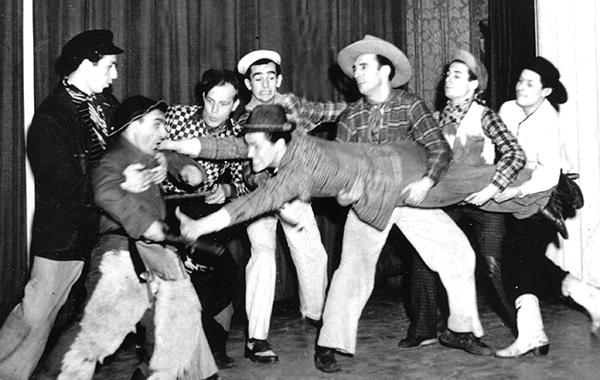
The group’s earliest members had grown up listening to and emulating the sounds and musical arrangements of vaudeville troops like Borrah Minevitch & His Harmonica Rascals and The Cappy Barra Harmonica Band, and, later, the Harmonicats, who, in 1947 lit up the airwaves with Peg O’ My Heart.
But, as time went on, music veered in other directions, with the diatonic playing an increasingly larger role in the charts and hearts of younger players and fans. Something had to give, but not everyone was on board.
Recalling those first turbulent times, Davies says, “There was a group of a more senior crowd when it started, and they were firmly attached to the trio sound.” But, if the organization was to survive and follow its mandate to preserve and advance the harmonica, it was going to have to expand its reach and focus.
There was, as they say, a period of adjustment.
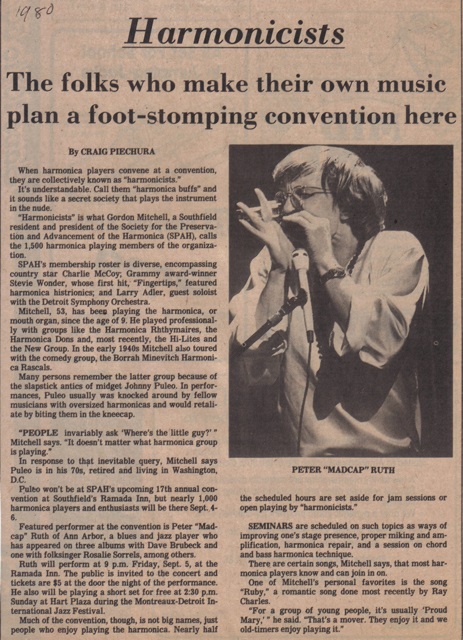
“The friction between the two groups was evident when it first started but it has long ago vanished,” says Davies, with players like Peter Madcat Ruth — the first diatonic player to perform at a SPAH convention — easing the way in 1980.
“He was the first diatonic player who won the hearts of the seniors because his playing was so diversified and so magnetic.”
By 1988, the mix was apparent, with Ruth, Charlie Musselwhite and Lee Oscar joining some of the world’s leading chromatic players on stage for the organization’s 25th Anniversary show.
And so it was that, as time went on, the membership and its offerings became more diverse, this, without forsaking the music that had been an integral part of the organization since its very beginning.
It was, after all, not about intrusion, but inclusion, with Davies doing his best to include as many different groups and genres as possible. “Trying to represent the trio world isn’t as easy as it once was,” he admits, given the fact that “there aren’t a lot of young players playing trio material, particularly when it comes to the chord.”
“But,” interjects Michael, “we’re starting to find a new generation of bass players.” A good sign, in that, while the song has ended, the melody lingers on, albeit in a new and decidedly different way. Which, he explains, is right in line with the organization’s mandate to “preserve the music and styling as it was played, when we can,” (he laughs), “even if it’s with a different instrument.
“Three or four years ago Madcat played his music with a bass and chord, and it was a great.”
This year, members will be treated to a new generation of trio performers, as SPAH scholars Norm Patton and AJ Windmeyer join Carl Rosetti for a fresh look at old standard.
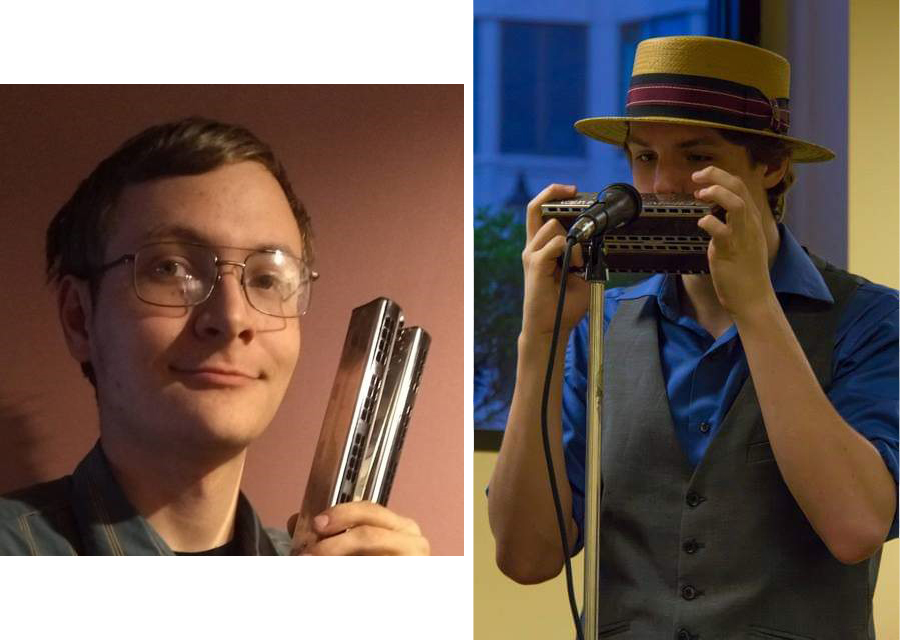
And so, while the trio world as we knew it may be disappearing, it is, in some ways, reinventing itself. Says Davies, “The diatonic world is blossoming and the progressive harmonica players who are playing chromatically on the diatonic have certainly blossomed another breed of people who shared their experiences on the harmonica with the chromatic players. They are playing fully chromatic style on the diatonic with overblows and overdraws. Madcat just turned 70; he started at 32 — we’re the old guard now.”
Over the years, SPAH has introduced its membership to players and genres that cover the waterfront. It is a marriage of sorts, offering up something old, something new, something tried, something true… all working together to preserve and promote the harmonica. And never is it more in view than at the organization’s annual convention, affectionately known as “SPAH”.
Summertime is prime time and so it is that, every year, sometime between mid-August and early September, suitcases will be packed, harmonicas pocketed, arrangements sorted, expectations heightened and seat belts fastened as members come from as far away as the UK, Germany and France, Australia and India to take part in this incredible four-night/five-day event.
This year’s convention (the group’s 56th!) is being held at the Hyatt Regency Hotel in Tulsa, Oklahoma, from August 12th through the 17th.

Those who want to jump-start the festivities arrive a day earlier, check into the hotel, and head for the International Blues Blowoff, an unofficial event whose registration fees are separate from the convention’s. It’s a complementary relationship,” explains Michael, with the Blowoff getting things off to a rockin’ good start.
It is at SPAH that amateurs and pros come together, catching up with old friends and getting to know new ones. Over the course of the convention they will share, teach, learn, hear and cheer each other on, and play from dusk to dawn if they care to.
They come from big towns and rural communities, some for the first time; others, time and time again.
Over the course of the convention, members will have a chance to hear harmonicas of every kind playing music of every description: Blues, rock, gospel, jazz, country, Cajun, Brazilian, rap — you name it, it’s all there, the music of their lives and those who came before them.
It is, in short, a harmonica lover’s idea of paradise: a chance to meet their idols, go to seminars that cover everything from the fundamentals to how to teach others and play — perhaps for the first time — in front of an audience, and improvise and harmonize in informal groups
Stay at the convention’s official hotel and you’ll find members playing everywhere you look — in private and public rooms, from the lobby, to the hotel’s nooks and crannies, inside and out, in clusters of twos and threes, and more, listening, learning and playing their hearts out.
Davies, who is the organization’s current Entertainment Director, recalled a rainy convention night in St. Louis some years ago, when a businessman walked into the lobby and looked around. “People were playing everywhere,” says Davies, “and he said to me ‘What is this? A harmonica convention?’” He laughs at the memory because, he says, “That’s exactly what it was.”
Over the course of the five day gathering, SPAH-goers will immerse themselves in everything harmonica: listening and learning the big and small things that will make each of them a better player and performer and songwriter.
It’s a jam-packed compendium of seminars and shows, open mics and teach-ins, outreach gatherings, conversations and music, lots and lots and lots of music.
The teach-ins give attendees the chance to sit down with one of 15 or 20 instructors like Dave Barrette, who, over the course of the next two hours, helps them with their playing.
Says Michael, “One of the things that came out of these teach-ins is that, as the music and the people have matured, there is a class of amazing players in all genres who we would like to have at SPAH to provide an immersive experience for our attendees.”
Paul picks up the conversation: “We have a treasure of people who have lived and breathed the harmonica their entire lives and we want to support them. And you just have to be there, engage others to play with you so that we don’t lose the old guard.”
Adds Michael, “And this year, we’ve started a troubadour program where we invite a group of some of our most valued members to come to SPAH. We ask them to simply be who they are, interacting with the members and sharing their memories, music, skills, techniques and love for the harmonica.”
“We offer jams in the evenings which cover everything from bluegrass to country blues gospel and jazz,” says Michael, as they continue to find ways to expand, giving members “the chance to listen to each other’s piece of the universe.” It is a heady mix, ranging from old favorites to new sounds, as members are introduced to music they have never heard before or at least not on the harmonica.
The group’s outreach programs further that goal, inviting young harmonica players from around the world to apply to come to SPAH as a “scholar” through the William Rosebush Scholarship Fund. “We solicit donations through members, sell raffle tickets at our conventions and have sponsor support.
“We also do a youth outreach in the city where the convention is held,” he continues. “It’s aimed at kids who might otherwise not have the opportunity to play music at all, including those who fall into the special needs category. Last year, we had about 80 people. We gave them each a harmonica, taught them how to play it, and had an Open Mic for them.”
The old, the new, the tried and true: memories are made of this.
And, speaking of memories, one of Paul’s favorites takes us back to a SPAH convention in the 1990s. “It was the beginning of the jazz jam in Detroit,” he says, “and I was asleep. And my roommate rattled my bed and said, ‘Get your butt downstairs and get down to the piano room.’
“It was a very small room, and there was William Galison, Charlie Leighton, Charles Spranklin and Ron Kalina and they were just sitting around the piano and playing jazz tunes. It was an absolutely magical moment. And that was at 2:30 in the morning and finished at four.
And, when it comes to memories, Michael says he’ll never forget the night when Stan Harper, who, at the age of 92, stepped up to the mic and wowed the crowd.
“It was amazing,” he says. “I told many people how I’d seen somebody in his 90s, solo in front of an audience of 500 people. It says something about the harmonica as a breathing apparatus.”
Another convention and another memory takes Michael from one end of the age spectrum to the other, as he recalls watching Cole Moran, one of SPAH’s scholars, take the stage.
“He was maybe 13 or 14 years old at the time, and I remember watching him interact with the audience. He was born blind and has cognitive delays but, when he gets on stage, it doesn’t matter. It just doesn’t matter. It’s almost like his body changes and all of a sudden he’s in command, and it’s magical. Music changes lives.”
This year’s convention is bound to do more of the same.
A small sampling of this year’s incredible playlist includes chromatic jazzman Yvonnick Prené, Nick Moss Band, featuring Dennis Gruenling, and the Charlie Musselwhite Band.
Also on the all-star line-up, Tom Stryker’s Big Band returns.
And the beat goes on, with an incredible assortment of top-flight entertainment that includes the Rob Roy Parnell Swing Band, Celtic player Donald Black and Mo Vint’s Harmonicats.
Saturday night is banquet night, and it’s a feast for the eyes and ears, with great food, great folks and a dynamic line-up.
It’s at the banquet where awards, nominated and voted upon by the membership, are awarded.
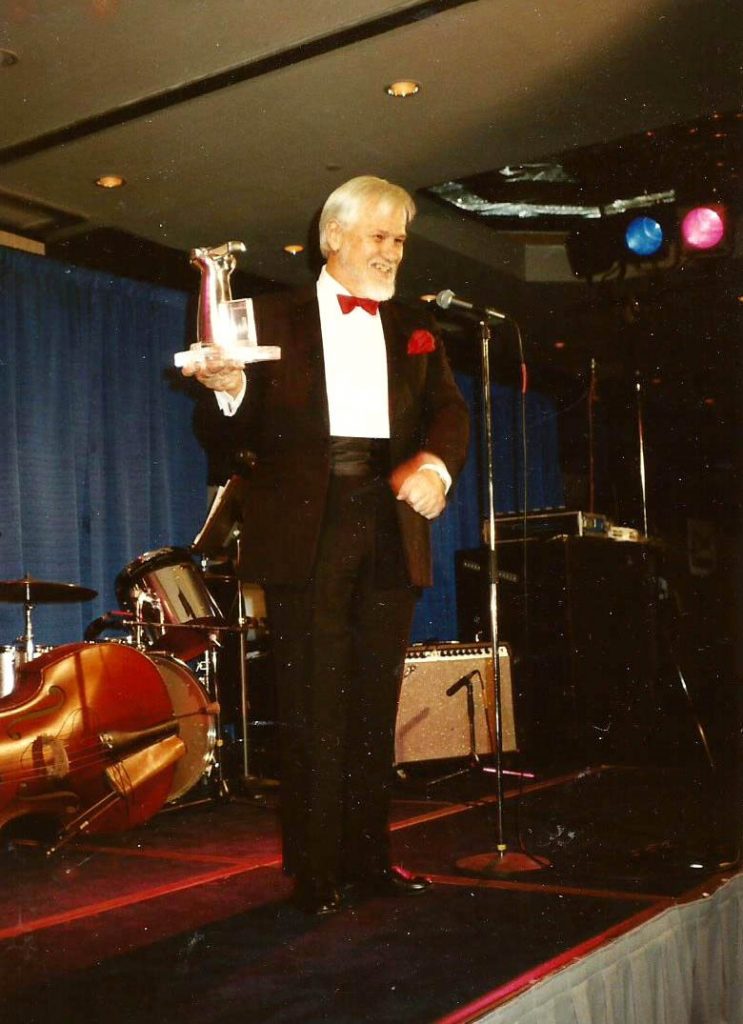
And here is where my heart lies, for, in addition to the prestigious Bernie Brea Player of the Year Award, President’s Award, Stan Harper Special Merit Award, and other much-coveted awards, there is the Pete Pedersen Lifetime Achievement Award.
I was there the day Pete received the award, learning for the first time that it had been renamed in his honor. I think that award meant more to him than any other honor he had received in his long and illustrious career because he was honored by his peers; not just the pros, or those in the music business, but by those who, like Pete, found incredible joy in playing and listening to the harmonica, and sharing that joy with others.
Pete was the very embodiment of what the organization stands for. A consummate entertainer, musician, composer and arranger, Pete gave of his talent freely, teaching, writing arrangements for members, and MC-ing and performing at numerous SPAH conventions, doing everything in his power to advance and promote the instrument he loved.
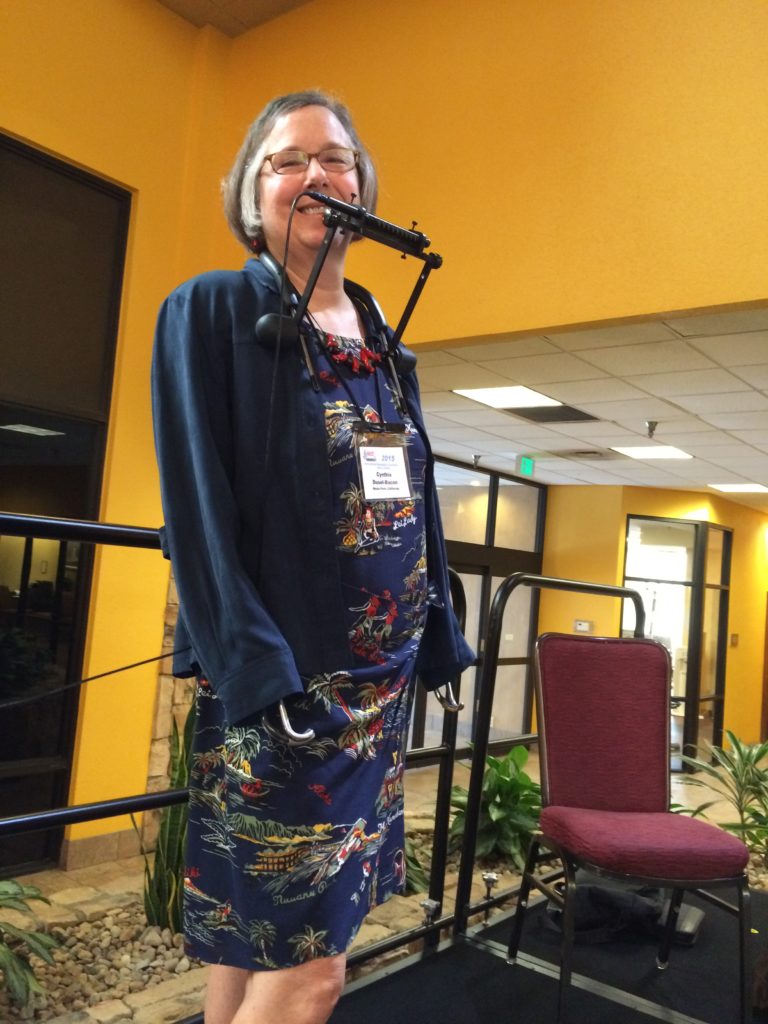
The Lifetime Achievement Award, like all of SPAH’s awards, gives members something to aspire to, marvel at and applaud. But then, the organization in general and the convention in particular offer up a million and one reasons to do so, including awe-inspiring performances by artists like Cynthia Dusel-Bacon.
Cynthia lost both arms in a bear attack back in 1977, but that hasn’t stopped her from living life to the fullest, a life that included playing the harmonica. Notes Paul, “She’s got a special harmonica by Vern Smith called ‘the hands-free chromatic’. It’s a head-bob: you move your jaw up and down and it engages the button.”
Over the years, there’s been a concerted effort to introduce more female players to the group and, this year, Lauren Williams will be taking the stage to deliver her brand of the blues.
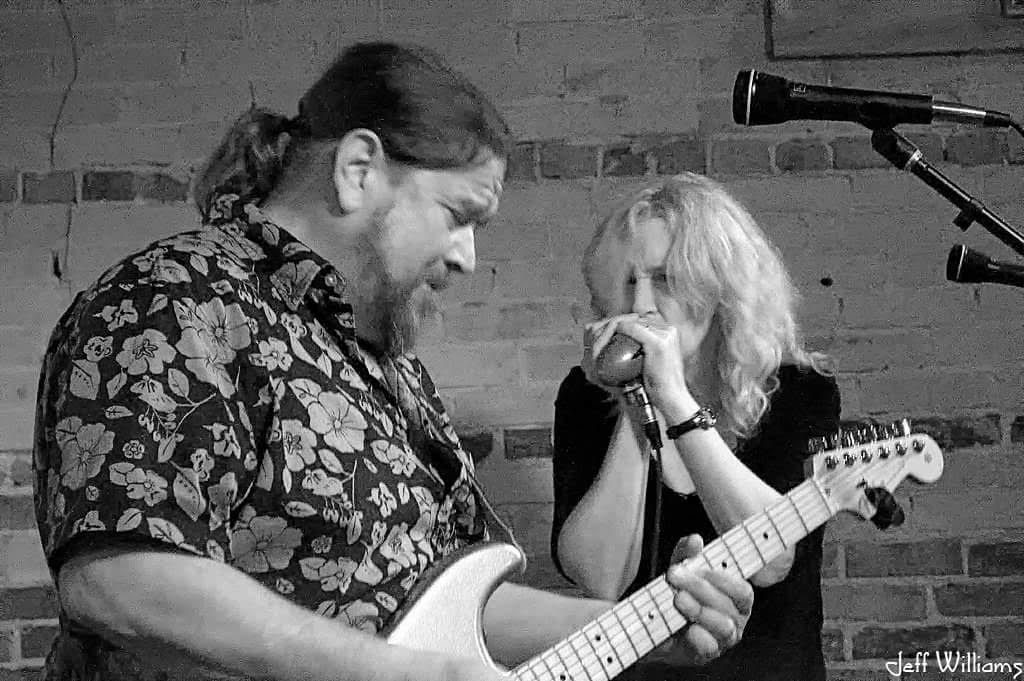
And that’s just a small sampling of the who’s who and what’s what at SPAH this year. Those wishing to spend a little Tulsa time outside the hotel can get their kicks on a tour of Route 66 and the National Cowboy and Western Heritage Museum, and/or sign up for a downtown historic trolley tour.
Registration for this year’s convention is already underway, convention-goers can register online or by mail through July 31st. After that, members can register at the hotel, while non-members can sign up and join in the fun.
Of course, not everyone can make it to the convention, says Michael. “But even if you can’t come to Tulsa, there’s value in what you do to support the harmonica and its music and all the cool discounts and workshops in your own home town.”
Throughout the year, local chapters meet, greet, play and plan, sponsor events and welcome new members, doing their part to preserve and promote the harmonica through the organization’s various programs.
And, for those who love the harmonica, it is a little bit of heaven. For more information on becoming a member, renewing your membership and/or signing up for the upcoming convention, go to SPAH.org.

Comments
Got something to say? Post a comment below.